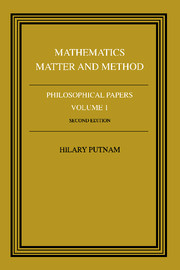Book contents
- Frontmatter
- Contents
- Dedication
- Introduction
- 1 Truth and necessity in mathematics
- 2 The thesis that mathematics is logic
- 3 Mathematics without foundations
- 4 What is mathematical truth?
- 5 Philosophy of physics
- 6 An examination of Grünbaum's philosophy of geometry
- 7 A philosopher looks at quantum mechanics
- 8 Discussion: comments on comments on comments: a reply to Margenau and Wigner
- 9 Three-valued logic
- 10 The logic of quantum mechanics
- 11 Time and physical geometry
- 12 Memo on ‘conventionalism’
- 13 What theories are not
- 14 Craig's theorem
- 15 It ain't necessarily so
- 16 The ‘corroboration’ of theories
- 17 ‘Degree of confirmation’ and inductive logic
- 18 Probability and confirmation
- 19 On properties
- 20 Philosophy of Logic
- Bibliography
- Index
7 - A philosopher looks at quantum mechanics
Published online by Cambridge University Press: 04 August 2010
- Frontmatter
- Contents
- Dedication
- Introduction
- 1 Truth and necessity in mathematics
- 2 The thesis that mathematics is logic
- 3 Mathematics without foundations
- 4 What is mathematical truth?
- 5 Philosophy of physics
- 6 An examination of Grünbaum's philosophy of geometry
- 7 A philosopher looks at quantum mechanics
- 8 Discussion: comments on comments on comments: a reply to Margenau and Wigner
- 9 Three-valued logic
- 10 The logic of quantum mechanics
- 11 Time and physical geometry
- 12 Memo on ‘conventionalism’
- 13 What theories are not
- 14 Craig's theorem
- 15 It ain't necessarily so
- 16 The ‘corroboration’ of theories
- 17 ‘Degree of confirmation’ and inductive logic
- 18 Probability and confirmation
- 19 On properties
- 20 Philosophy of Logic
- Bibliography
- Index
Summary
Those defile the purity of mathematical and philosophical truthy who confound real quantities with their relations and sensible measures.
—ISAAC NEWTON, PrincipiaBefore we say anything about quantum mechanics, let us take a quick look at the Newtonian (or ‘classical’) view of the physical universe. According to that view, nature consists of an enormous number of particles. When Newtonian physics is combined with the theory of the electromagnetic field, it becomes convenient to think of these particles as dimensionless (even if there is a kind of conceptual strain involved in trying to think of something as having a mass but not any size), and as possessing electrical properties – negative charge, or positive charge, or neutrality. This leads to the well-known ‘solar system’ view of the atom – with the electrons whirling around the nucleons (neutrons and protons) just as the planets whirl around the sun. Out of atoms are built molecules; out of molecules, macroscopic objects, scaling from dust motes to whole planets and stars. These latter also fall into larger groupings – solar systems and galaxies – but these larger structures differ from the ones previously mentioned in being held together exclusively by gravitational forces. At every level, however, one has trajectories (ultimately that means the possibility of continuously tracing the movements of the elementary particles) and one has causality (ultimately that means the possibility of extrapolating from the history of the universe up to a given time to its whole sequence of future states).
- Type
- Chapter
- Information
- Mathematics, Matter and MethodPhilosophical Papers, pp. 130 - 158Publisher: Cambridge University PressPrint publication year: 1979
- 4
- Cited by



